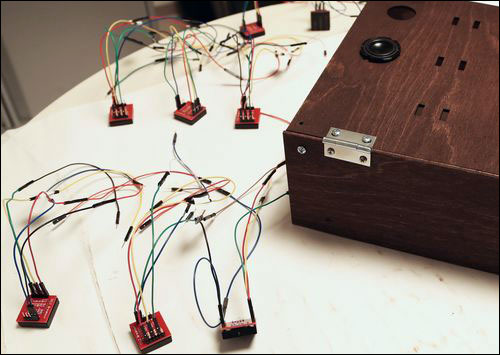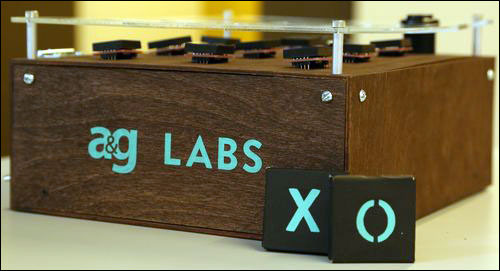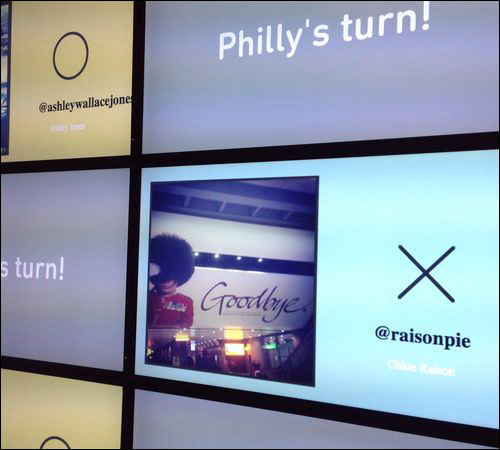At advertising agency Allen & Gerritsen‘s two East Coast offices, the traditional pencil-and-paper game of tic-tac-toe has been transformed into a virtual, two-city contest using digital displays and featuring images from staff members’ Instagram accounts, along with Xs and Os, via RFID readers and tags.
The company has been testing radio frequency identification technology as one strategy to bring new consumer engagement to the world of marketing. But while its goal is RFID-enabled marketing strategies for its clients, the firm’s own employees are having fun with it in the meantime. The company’s research-and-development unit, A&G Labs, launched two years ago, has been experimenting with RFID and other technology innovations. Last week, the company installed an RFID system enabling players at two of its office (in Boston and Philadelphia) to engage virtually. The game consists of a low-frequency (LF) passive RFID tag attached to each playing piece, as well as RFID readers built into squares on the board that are linked to the Instagram pictures via A&G Labs software. As employees at the agencies play the new game, the company hopes to demonstrate to clients how RFID could bring greater excitement to marketing.

In the long term, says George Ward, A&G’s senior VP of innovation, the company intends to provide solutions that could utilize RFID or other wireless technologies in a variety of ways. For example, they might be used in loyalty cards that could be identified as a customer enters a store, or a particular department within that store, and thereby enable the company to display offers and discounts on a screen relevant to that individual. “Our short term is to get to know the technology,” Ward explains, while the long-term goal is to develop solutions that clients can adopt to further engage customers.
The main purpose of the RFID game, known as Pic-Tap-Toe, was to bring the two offices closer together. Allen & Gerritsen acquired Neiman, located in Philadelphia, in June 2013, and researchers at the R&D lab developed the game to help staff members at the offices to meet each other digitally. Ward says he has been through acquisitions before, and knows that they proceed more smoothly when personnel have a chance to interact—even if they are in remote locations.

As it happened, Ward says, each office had its own wall of nine digital screens, in a common area used for displaying promotional information for clients, such as looping videos of the company’s solutions. With RFID, the researchers envisioned, those screens could help employees from the two separate offices to interact, just as retailers and other clients could engage with consumers via in-store digital displays.
A&G Labs had considered deploying a system by which an individual could tap a reader with an ID card linked to his or her own data, thus prompting a display indicating that person’s daily schedule. However, Ward says, employees could be reluctant to display their schedules on a public screen. Instead, the researchers developed an idea involving Instagram, enabling staff members to share their Instagram pictures with others in the corresponding office.
Limited by a budget of only $2,000, the A&G Labs team developed a custom-designed game board consisting of an array of nine LF RFID readers mirroring the nine video screens mounted on each office’s wall. To create the playing pieces, the A&G Labs staff made wooden tiles, each printed with an X or O fitted with a 16-millimeter (0.6-inch) 125 kHz SparkFun RFID button tag, and with a unique ID number encoded to that tag, indicating it as an X or O piece. (X pieces were assigned to one office, Os to the other.) Each game board—representing a tic-tac-toe grid—has nine SparkFun 12LA RFID readers, each positioned behind a specific grid square. When a player places a tile on a square, the interrogator captures the tag’s ID number. The microcontroller built into the board determines which reader performed the read, and forwards the data back to the dedicated server via a Wi-Fi connection. The server then pulls a random picture from the pool of the employees’ Instagram images, displaying it on the corresponding video wall screen at each office. A staff member at the other office is then invited to respond with his or her own play, and another Instagram picture is randomly selected and displayed. Ultimately, the game is played until one team wins or a tie is achieved, and the tiles are then removed from the boards so the game can begin again. To date, 47 employees have shared their Instagram streams via the game.

The companies did face some challenges in developing the game, Ward says. Because the readers were positioned within inches of each other in the game board, it was important to use LF technology, with its very close read range, in order to ensure against stray reads. Of the 18 readers received, he notes, five needed to either be shielded with aluminum to ensure they did not pick up stray reads, or be replaced with new readers.
The game not only brings staff members from the physically separated offices together, but also serves as a promotional piece for the agency’s technology innovations. Clients can view the game, while workers are being invited to create ideas around ways in which RFID could be used by those clients.
In the case of digital signage, Ward says, either RFID or iBeacon—Apple‘s version of Bluetooth Low Energy (BLE) technology (see Companies Deliver New Apps for Bluetooth Beacons)—could be used to identify individuals entering a place of business, and to then send them promotional materials. For example, he says, software paired with RFID or iBeacon technology could collect the ID number of a customer’s loyalty card or phone, and thereby calculate the appropriate promotion for that individual, based on his or her spending habits. For example, if that patron typically buys a 20-ounce coffee using an RFID-based loyalty card that enables the store to maintain a record of every transaction, the software could trigger the displaying of a coupon for a 24-ounce coffee. The same goal could be achieved, he says, by offering two sandwiches at a discount to someone who typically purchases a specific type of sandwich.


